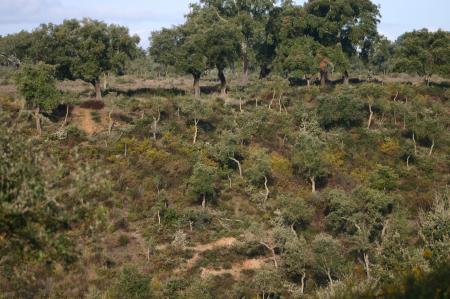
Objective:
The cork oak forest management involves interventions in the understory with the following objectives: reduction of the fire risk, operationality of the cork harvesting, promotion of cork oak recruitment and reduction of competition for water and nutrients between trees, herbs and shrubs. The techniques currently available for the forest producer to carry out these operations are: the practice of grazing and / or mechanized interventions (harrowing, shrub cutter, shredding). The choice among several mechanical techniques should consider cork oak sustainability and the potential impacts over soil & plants.
Context:
Mechanization in the 20th century generalized the use of agricultural implements in agriculture and in agro-forestry systems. In the Iberian Peninsula, this phenomenon has been associated with tractors of greater power that have replaced animal traction. This fact had serious impacts on the natural regeneration, roots and vitality of the cork oaks.
Recent studies show that the loss of trees in the cork forest is more linked to the impact of vegetation control systems with soil mobilization (mainly in soils with depth limitations and slopes > 15%) than to climate changes (6).
Contacts:
Conceição Santos Silva, mcssilva@unac.pt, www.unac.pt
Further information:
- Aronson, J.; Pereira, J.S.; Pausas, J.G. (Eds), 2009 - Cork Oak Woodlands on the Edge – Ecology, Adaptative Management, and Restoration. Island Press
- Barros, M.C.O.; Calado, N.; Gomes, A.A.; Inácio, M.L., Lopes, F.J.; Marcelino, A.C.; Sousa, E.; Varela, M.C., 2006 - Boas práticas de gestão em sobreiro e azinheira. DGRF. LISBOA
- David, T.S., Pinto, C.A., Nadezhdina, N., Kurz-Besson, C., Henriques, M.O., Quilhó, T., Cermak, J., Chaves, M.M., Pereira, J.S. & David, J.S., 2013 - Root functioning, tree water use and hydraulic redistribution in Quercussuber trees: A modeling approach based on root sap flow. Forest Ecology and Management 307: 136–146
- David, T.S., Pinto, C.A., Nadezhdina, N., David, J.S. 2016 - Water and forests in the Mediterranean hot climate zone: a review based on a hydraulic interpretation of tree functioning. Forest Systems 25 (2) e R02. 14p
- Dinis, C., 2015 - Análise das estruturas dos sistemas radiculares de sobreiro: modelação da arquitectura e da interface solo-água. Comunicação na FICOR
- ICAAM, 2013 - Livro verde dos montados. Universidade de Évora